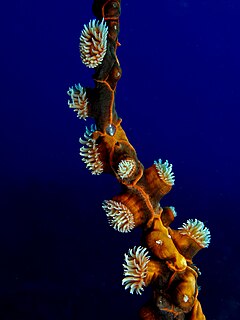
Tube-dwelling anemones or ceriantharians look very similar to sea anemones but belong to an entirely different subclass of anthozoans. They are solitary, living buried in soft sediments. Tube anemones live inside and can withdraw into tubes, which are composed of a fibrous material made from secreted mucus and threads of nematocyst-like organelles known as ptychocysts. Within the tubes of these ceriantharians, more than one polyp is present, which is an exceptional trait because species that create tube systems usually contain only one polyp per tube. Ceriantharians were formerly classified in the taxon Ceriantipatharia along with the black corals but have since been moved to their own subclass, Ceriantharia.

Actinoscyphia is a genus of sea anemones of the family Actinoscyphiidae.

Edwardsia is a genus of sea anemones, the type of the family Edwardsiidae. They have eight mesenteries and live in tubes in the sand. The name, in New Latin, commemorates the French zoologist Henri Milne-Edwards.

Amphianthus is a genus of sea anemones. It is the only genus in the monotypic family Amphianthidae.

Hormathiidae is a family of sea anemones in the class Anthozoa.

Pseudactinia is a genus of sea anemones in the family Actiniidae.

Bunodactis is a genus of sea anemones in the family Actiniidae.

Epiactis is a genus of sea anemones in the family Actiniidae. There are about nineteen recognised species and the type species is Epiactis prolifera.

Parazoanthus is a genus of anemone-like anthozoans in the order Zoantharia.

Actinia is a genus of sea anemones in the family Actiniidae. Actinia display a rare form of heteromorphosis in which a cut inflicted on a specimen can develop into a second mouth.

Liponema is a genus of sea anemones, in the family Liponematidae.

Peachia is a genus of sea anemone in the family Haloclavidae. Members of this genus typically burrow into soft substrates. The only part of the animal that is normally visible is the oral disc and tentacles which lie flat on the sand in a star shape. The type species is Peachia cylindrica.

Anemonia is a genus of sea anemones belonging to the family Actiniidae.

Palythoa is a genus of anthozoans in the order Zoantharia.

Actinostolidae is a family of sea anemones in the order Actiniaria. Members of this family are deep sea species, with some occurring at hydrothermal vents.

Actinostola callosa is a species of sea anemones in the family Actinostolidae in the order Actiniaria. It is a deep sea species and occurs in both Pacific and Atlantic Oceans from the continental shelf to abyssal depths.

Diadumene is a genus of sea anemones. It is the only genus in the monotypic family Diadumenidae.

Pachycerianthus is a genus of marine tube-dwelling anemones in the family Cerianthidae.

Bolocera is a genus of sea anemone in the family Actiniidae.
Actinostella is a genus of sea anemones in the family Actiniidae.



















